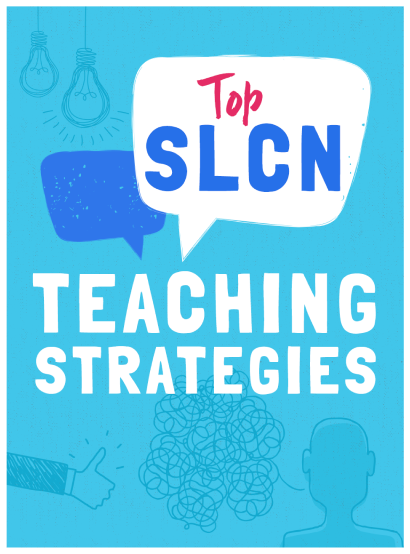SLCN – What schools need to know to support children

Learn what SLCN means, how to identify it in children and how best to support them, with real-life examples from UK schools…

- by Teachwire
- Classroom expertise and free resources for teachers

Table of contents
SLCN meaning
SLCN stands for speech, language and communication needs. It’s a serious yet common developmental disorder, accounting for almost a quarter of SEND pupils, according to government statistics.
Around 10% of children starting school have some form of speech and language impairment. Indeed, it’s the most prevalent childhood disability.
The consequences of missed diagnoses can be severe. Between 50 and 90% of children with persistent speech, language and communication difficulties go on to have reading difficulties. Speech impairment is present in two-thirds of seven- to 14-year-olds with serious behaviour problems.
SLCN is also associated with many other types of SEN. This includes autism spectrum disorder and general/specific learning difficulties.
Why identifying SLCN early is essential
Spotting SLCN as early as possible is one of the keys to successful outcome in speech and language therapy and learning as a whole, says consultant speech and language therapist Shermeena Rabbi…
As the old proverb puts it, it takes a village to raise a child. While parents will do anything in their power to give their child the best possible start in life, they can’t get everything right.
When the baton of responsibility passes from parent to schools, teachers take on the awesome responsibility of identifying children’s developmental challenges. This includes those that parents have missed.
When parents fail to spot these problems or take a laissez-faire, ‘wait-and-see’ attitude, it magnifies the importance of teacher intervention.
Identifying SLCN early is one of the keys to successful outcome in speech and language therapy.
While adults and older children can of course be treated successfully, the task is made so much easier by identifying potential SLCN during the ‘golden period’. This is typically between three and five years old.
“The task is made so much easier by identifying potential SLCN during the ‘golden period’”
This is where primary teachers have such an important role to play: not just by identifying speech problems, but by communicating them effectively to parents so that everyone can play their part in the solution.
SLCN diagnosis and support tools
- WellComm Primary – Identifies specific aspects of a child’s speech and language and social communication skills that are a cause for concern. Provides the resources needed to plan targeted intervention within schools and settings in the accompanying ‘Big Book of Ideas.’
- Ten Minute Box – Aimed at learners who have mastered single sound phonics but have difficulties recognising digraphs and blending sounds. Everything you need is included in the box.
- Infant Language Link – Online assessment and intervention package enabling schools to identify and provide timely support for children with SLCN.
Symptoms of SLCN to look out for
Not every speech problem is as noticeable as a stammer or mispronunciations. Teachers and SENCo staff, therefore, need to understand the signs that can often be mistaken for introspection or learning difficulties.
These include:
- attention and listening difficulties
- problems remembering instructions
- difficulties answering questions or making themselves understood
- being the last to complete a task or piece of work
Other red flags include:
- immature vocabulary or grammar
- difficulties making friends
- non-compliance with instructions
- giving strange or unusual responses to questions
Of course, there may be other reasons for any of these factors. However, we should all be aware that these could well be a sign that the child has SLCN.
Whatever the reason behind their speech and language development, taking the right approach to communication will have a positive effect.
How to support children with SLCN
There are a number of strategies that we can use to improve our communication with children who are struggling with speech and language.
These range from exercises designed to test and improve memory, through to attention and listening, understanding, working on expressive language, phonology and social communications.
Memory
To build children’s memory, ask pupils to repeat exactly what you’ve said to them. Gradually build in longer delays between instruction and repetition.
Exercises like Kim’s Game or the ‘shopping list’ (“I went to town and bought an apple, some bacon, a cabbage,” and so forth down the alphabet) are fun ways to help children with both concentration and memory.
Attention and listening
This is another area where teachers can make a real difference. Tactics range from securing a child’s attention by calling their name before giving an instruction, to taking a more visual approach with cue cards and task management boards. These provide pictorial instructions of the stages of an activity.
It’s also important to ask pupils to listen out for specific information before delivering your lesson (for example, “I want you to tell me what food the Romans ate”). Ensure to place children with SLCN away from distractions such as open windows or disruptive pupils.
Understanding
To boost children’s understanding, encourage the use of rehearsal. Ask open-ended questions to check their comprehension of the task you’ve asked them to perform.
Giving clear, short and ‘chunked’ instructions – where you separate commands into simple, easily digestible bites, given in the order they’re supposed to be carried out – can also have a tremendous effect on pupils’ understanding.
It’s also important to augment verbal instructions with visual cues, gestures and signing. For example, use hand gestures to teach different tenses (left hand for ‘past’ and right hand for ‘present’).
Bolster these activities with ongoing comprehension monitoring. This encourages students to identify when they have not understood instructions because they were too fast, quiet or complicated.
Expressive language
One of the biggest challenges with speech and language problems is that they are self-reinforcing. If a child has problems expressing themselves, they are likely to become frustrated and retreat further into their shell.
On the other hand, helping them with their expressive language can have a huge bolstering effect on their confidence and help them to fall in love with communication.
To aid expressive language, use Colourful Semantics or Shape Coding to help students understand what elements they need within a sentence. Repeat the pupil’s sentences and add information to it to encourage them to develop their spoken language.
Other techniques include using puppets or toys to act out simple stories. Use talking or writing frameworks to help students tell oral or written narratives.
None of these steps promises a ‘cure’ for SLCN. However, they’re every bit as important as the future work that the child will do with their speech therapist.
By identifying problems early on and taking simple, effective steps that are focused on fostering understanding and communication, we can help to draw children out of the prison of language that they inhabit, and provide them with a foundation on which speech therapists can build further language skills and confidence.
Shermeena Rabbi is a consultant speech and language therapist and founder of Unlocking Language.
Apps to support children with SLCN
Mandy Grist, lead advisor for communication at I CAN explains which SLCN apps actually work, and how to use them…
Apps can enhance vocabulary development, whilst also supporting children’s understanding of early language concepts. Of course, we shouldn’t use them as a replacement for face-to-face interaction, but rather as a tool to supplement teaching and learning.
Crucially, it is the interaction between adult and child that supports language development. Apps are a way of facilitating this interaction in the same way as a book or some toys might do.
When using apps to support communication in a setting, remain present to support children’s understanding and use of learning within the app.
- Smarty Ears apps are a good place to start. They feature a range of different activities to support language skills, including using adjectives, sentence building and describing.
- Splingo is particularly effective for interactive activities and providing instructions of increasing length and complexity.
- Additionally, The National Literacy Trust has produced an online apps guide, giving their views on the best apps to support children’s early language and literacy skills.
Questions to ask
- Is the app designed for the age group you are targeting?
- Are the aims of the app clear?
- Does the app allow you to set levels of challenge?
- Is the app easy for children to navigate?
- Does the app prompt children to ask questions and reflect on their actions?
SLCN school case study: Aerodrome Primary

With the right support, even children with severe SLCN can access mainstream education, says journalist Jacob Stow – just look at what’s going on at Aerodrome Primary Academy…
“We used to rely on children coming to school speaking, but that’s not always the case now,” explains headteacher, Zoe Foulsham.
“It’s increasingly a problem. Every year there are more cases of speech and language delay, and in some cases disorders. It’s the biggest need in Croydon today, and it’s been a hidden need for many years. It’s causing issues across the country.”
“We used to rely on children coming to school speaking, but that’s not always the case now”
While prevention is always better than cure, Aerodrome’s response to the challenges their children face is a fantastic example of the impact that determined schools can have when faced with such issues.
So impressive has it been, in fact, that the school was named ‘Primary School of the Year’ at the Shine A Light Awards, which recognises excellent practice in supporting children and young people’s communication development.
“We’ve set up the whole school for oracy,” says Zoe, summing up Aerodrome’s approach. “Everything we do, from early years all the way through, is based on talking.”
To back up that claim she can point to a host of initiatives that are making a difference in the classroom, as well as a dedicated Speech & Language Resource Centre.
The latter was originally created to support those with SLCN, but is now also helping to disseminate excellent practice throughout the school. Even the learning environment has been resourced with the need to get kids chatting firmly in mind.
Specialist support
“We were asked to have the resource centre here by the local authority during my first year at Aerodrome,” Zoe explains.
“I think they realised the school could do really great things because we had the right team in place. Although it’s a fully integrated part of the academy, it’s funded by the LA and children come from all over Croydon.
‘We only support a relatively small number of children with more pronounced SLCN. We have 17 at the centre at the moment (though there have been up to 19), which is based on adult ratios and what we can manage in terms of giving them the best support
“However, we’ve come to apply a similar approach to that used in the centre with all the children in our school.”
Those who come to use the centre itself benefit from a sizeable, open learning environment. “It’s not just an add-on room,” Zoe notes.
A specialist team, led by assistant head Vicky Prigg, provide the support necessary to help individuals develop the skills they need to succeed in mainstream classrooms.
Bespoke curriculum
There’s no question of a ‘one size fits all’ approach, with each child receiving a bespoke curriculum tailored to their needs: “If a child is really strong at maths, for example,” Zoe says, “they might be taught that subject in the mainstream classroom while spending time in the centre to work on communication skills.
“Of course that means that all of our staff have to be really skilled in teaching communication; we have to have a whole-school view on it.”
“There’s no question of a ‘one size fits all’ approach”
Within the centre, the focus is firmly on speaking and listening, with priority given to the development of functional language skills and the confidence needed for communication.
Parents are invited in to regular meetings, at which staff model specific strategies that can be employed at home.
Staff here regularly provide training to NQTs and students, too, aiding early identification and support strategies for pupils with SLCN within Aerodrome and other mainstream schools in the locality.
This flow of knowledge is enhanced by the fact that specialists, such as Vicky and speech and language therapist Maxine Whitmore, are to be found working across the school, particularly in the early years, in an effort to minimise the impact SLCN has on children’s education.
As a result, many strategies initiated in the centre are today benefiting children far beyond its four walls.










